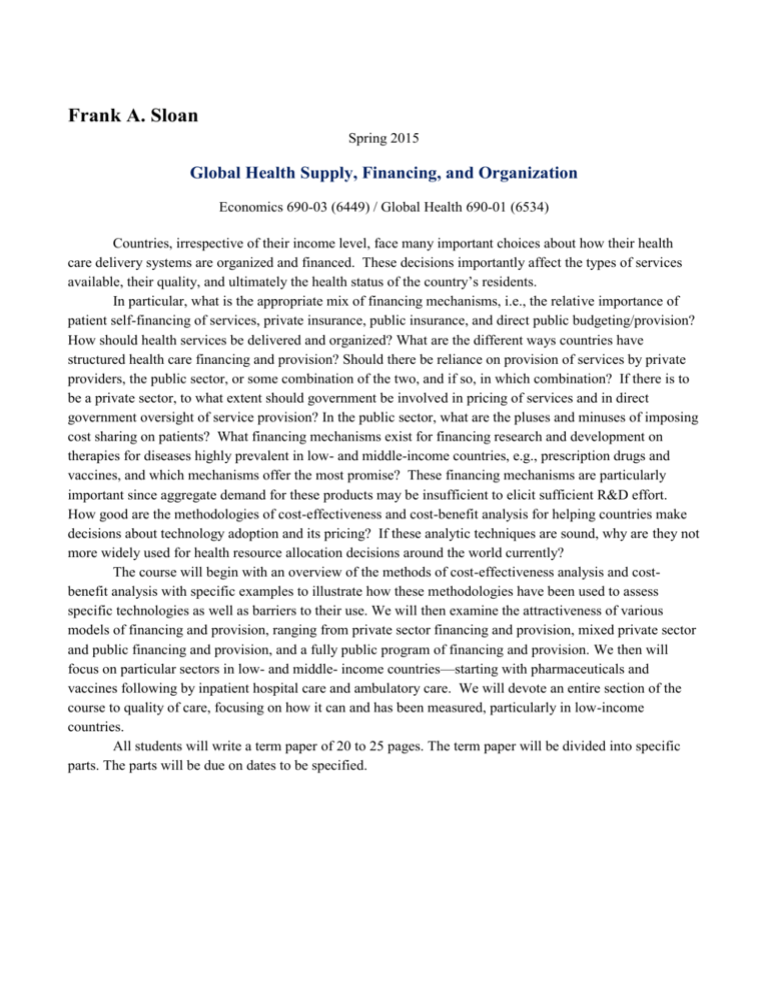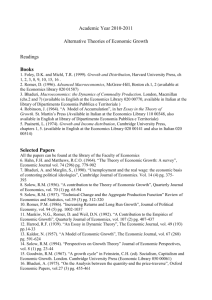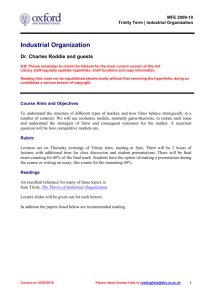ECON 690. Global Health Supply, Financing, and
advertisement

Frank A. Sloan Spring 2015 Global Health Supply, Financing, and Organization Economics 690-03 (6449) / Global Health 690-01 (6534) Countries, irrespective of their income level, face many important choices about how their health care delivery systems are organized and financed. These decisions importantly affect the types of services available, their quality, and ultimately the health status of the country’s residents. In particular, what is the appropriate mix of financing mechanisms, i.e., the relative importance of patient self-financing of services, private insurance, public insurance, and direct public budgeting/provision? How should health services be delivered and organized? What are the different ways countries have structured health care financing and provision? Should there be reliance on provision of services by private providers, the public sector, or some combination of the two, and if so, in which combination? If there is to be a private sector, to what extent should government be involved in pricing of services and in direct government oversight of service provision? In the public sector, what are the pluses and minuses of imposing cost sharing on patients? What financing mechanisms exist for financing research and development on therapies for diseases highly prevalent in low- and middle-income countries, e.g., prescription drugs and vaccines, and which mechanisms offer the most promise? These financing mechanisms are particularly important since aggregate demand for these products may be insufficient to elicit sufficient R&D effort. How good are the methodologies of cost-effectiveness and cost-benefit analysis for helping countries make decisions about technology adoption and its pricing? If these analytic techniques are sound, why are they not more widely used for health resource allocation decisions around the world currently? The course will begin with an overview of the methods of cost-effectiveness analysis and costbenefit analysis with specific examples to illustrate how these methodologies have been used to assess specific technologies as well as barriers to their use. We will then examine the attractiveness of various models of financing and provision, ranging from private sector financing and provision, mixed private sector and public financing and provision, and a fully public program of financing and provision. We then will focus on particular sectors in low- and middle- income countries—starting with pharmaceuticals and vaccines following by inpatient hospital care and ambulatory care. We will devote an entire section of the course to quality of care, focusing on how it can and has been measured, particularly in low-income countries. All students will write a term paper of 20 to 25 pages. The term paper will be divided into specific parts. The parts will be due on dates to be specified. The topics of the term papers are open. One idea is to take a topic, which we cover in class and see if there is an additional material for a country of particular interest to you. I do want the topics to be related to supply, financing, and/or organization of health care services. Thus, for example, a paper on a demographic topic would not be appropriate unless it can be directly linked to supply, financing, and/or organization of personal health care services. My preference is that you write your paper on another country or countries other than your own. Spring 2015 Duke University T & Th, 4:40-5:55PM Frank Sloan Global Health Supply, Organization, and Financing: Economics 690 / Global Health 690 January 8 I. Introduction and Overview Banerjee, A. and E. Duflo, “The Economic Lives of the Poor,” Journal of Economic Perspectives, vol. 21, no. 1, Winter 2007, pp. 141-167. Besley, T. and T. Persson, “Why Do Developing Countries Tax So Little,” Journal of Economic Perspectives, vol. 28, no. 4, Fall 2014, pp. 99-120. January 13 II. Economic Evaluation of Technologies A. Overview B. Cost-effectiveness Analysis 1. Overview Sloan-Hsieh, Health Economics. Chapter 14. “Cost and CostEffectiveness Analysis” 2. Applications Kahn, J, E. Marseille, and B. Auvert, “Cost-Effectiveness of Male Circumcision for HIV Prevention in a South African Setting,” PLOSMedicine, vol. 3, no. 12, December 2006, pp. 2349-2258. January 15 Chinkhumba, J., S. Godlonton, and R. Thornton, “The Demand for Medical Male Circumcision,” American Economic Journal: Applied Economics, vol. 6, no. 2, 2014, pp. 152-177. Goldie, S.J., Y. Yazdanpanah, E. Losina et al., “Cost-Effectiveness of HIV Treatment in Resource-Poor Settings—The Case of Côte d’Ivoire, New England Journal of Medicine, vol. 355, no. 11, September 14, 2006, pp. 1141-1153. January 20 C. Cost-Benefit Analysis 1. Overview Sloan-Hsieh, Health Economics. Chapter 15. “Measuring Benefits and CostBenefit Analysis” 2. Applications Jeuland, M, M. Lucas, J. Clemens, and D. Whittington, “A Cost-Benefit Analysis of Cholera Vaccination Programs in Beira, Mozambique,” The World Bank Economic Review. vol. 23, no. 2, 2009, pp. 235-267. January 22 D. Use of these Methodologies in Decision Making Ngorsuraches, S., W. Meng, B.-Y. Kin, et al., “Drug Reimbursement Decision-Making in Thailand, China, and South Korea,” Value in Health, vol. 15, 2012, pp. 5120-5125. January 27 III. System Design: Alternative Approaches A. Private Provision, Private Financing Sloan-Hsieh, Health Economics. Chapter 11. “Private Provision and Private or Mixed Financing” B. Private Provision, Private Financing Sloan-Hsieh, Health Economics. Chapter 12. “Government Financing and Private Supply” Wagstaff, “Social Health Insurance Reexamined,” Health Economics. Vol. 19, 2010, pp. 503-517. January 29 C. Private Provision, Private Financing Sloan-Hsieh, Health Economics. Chapter 13. “Public Supply and Financing” February 3 IV. Economics of Pharmaceuticals and Vaccines A. Pharmaceuticals 1. Overview Sloan, F.A. and C-R. Hsieh,** “The Effects of Incentives on Pharmaceutical Innovation,” Chapter 9, in Incentives and Choice in Health Care. Towse, A., E. Knffel, H. E. Kettler et al.,” Drugs and Vaccines for Developing Countries,” In Danzon, P. M. and S. Nicholson, eds., The Oxford Handbook of the Economics of the Biopharmaceutical Industry. Oxford: Oxford University Press, 2012, pp. 302-335. February 5 2. Pharmaceutical and Vaccine Markets Danzon, P.M. and M.F. Furukawa, “Prices and Availability of Biopharmaceuticals: An International Comparison,” Health Affairs, vol. 25, no. 5, 2006, pp. 1353-1362. Goodman, C. S.P. Kachur, S. Abdulla, P. Bloland, and A. Mills, “Concentration and Drug Prices in the Retail Market for Malaria Treatment in Rural Tanzania,” Health Economics. vol. 18, 2009, pp. 727-742. Sloan, F. A., “The Economics of Vaccines,” In Danzon and Nicholson, eds., op. cit., pp. 524-551 February 10 Barham, T. and J.A. Maluccio, “Eradicating Diseases: The Effect of Conditional Cash Transfers on Vaccination Coverage in Rural Nicaragua,” Journal of Health Economics. 28(2009), pp. 611-621. 3. Incentives for Innovation Kyle, M. K., and A. M. McGahan, “Investments in Pharmaceuticals Before and After TRIPS,” Review of Economics and Statstics, vol. 94, no. 4, November 2012, pp. 1157-1172. February 12 Ridley, D.B., H.G. Grabowski, and J.L. Moe, “Developing Drugs for Developing Countries,” Health Affairs. 25(2), March/April 2006, pp. 313324. Berndt, E.R., R. Glennerster, M.R. Kremer, J. Lee, R. Levine, G. Weizäcker, and H. Williams, “Advance Market Commitments for Vaccines Against Neglected Diseases: Estimating Costs and Effectiveness,” Health Economics. vol. 16, 2007, pp. 491-511. February 17 MID-TERM EXAMINATION February 19 V. Hospital and Ambulatory Care A. Hospitals 1. Overview Sloan-Hsieh, Health Economics. Chapter 6. “Hospitals” 2. Hospital Ownership and Performance Richman, BD, K Udayakumar, W. Mitchell, and K.A. Schulman, “Lessons from India in Organizational Innovation: A Tale of Two Heart Hospitals.” Health Affairs. Vol. 27, no. 5, Sept-Oct. 2008, pp. 1260-1270. Singh, N., “Decentralization and Public Delivery of Health Care Services in India.” Health Affairs. 27(4): July/Aug. 2008, pp. 9911001. February 24 Yip, W. and W. Hsiao, “Harnessing the Privatization of China’s Fragmented Healthcare Delivery,” Lancet, vol. 384, 2014, pp. 805-818. Lien, H-M, S-Y. Chou, and J-T. Liu, “Hospital Ownership and Performance: Evidence from Stroke and Cardiac Treatment in Taiwan.” Journal of Health Economics. 27: 2008, pp. 1208-1023. 3. Paying for Hospital Care Perkins, M., E. Brazier, E. Themmen, B. Bassane, D. Diallo, A. Mutunga, T. Mwakajonga, and O. Ngodola, “Out-of-Pocket Costs for Facility-Based Maternity Care in Three African Countries. Health Policy and Planning. Vol. 24, 2009, pp. 289-300. February 26 Triunfo, P., and M. Rossi, The Effect of Physicians’ Remuneration System on the Caesarean Section Rate: The Uruguayan Case, International Journal of Health Care Finance and Economics. Vol. 9, 2009, pp. 333-345. Kornai, J. “The Soft Budget Constraint Syndrome in the Hospital Sector,” International Journal of Health Care Finance and Economics. Vol. 9, 2008, pp. 117-135. Eggleston, K., Y-C. Shen, M. Lu, C. Li, H. Wang, and J. Zhang, “Soft Budget Constraints in China: Evidence from the Guangdong Hospital Industry.” International Journal of Health Care Finance and Economics. Vol. 9, 2008, pp. 233-242. March 3 4. Regulation Fang, J., “The Chinese Health Care Regulatory Institutions in an Era of Transition.” Social Science & Medicine. 66: 2008, pp. 952962. Kan, K, S.-F. Li, W.-D. Tsai, “The Impact of Global Budgeting on Treatment Intensity and Outcomes,” International Journal of Health Care Finance and Economics, vol. 14, 2014, pp. 311-337. Bloom, G., B. Kanjllal, and D.H. Peters, “Regulating Health Care Markets in China and India.” Health Affairs. Vol. 27, no. 4, July/Aug. 2008, pp. 952-963. March 5 B. Ambulatory Care and Physicians 1. Overview Sloan-Hsieh, Health Economics, Chapter 5. “The Market for Physicians’ Services” Golden, B.R. and F.A. Sloan, “Physician Pay for Performance: Alternative Perspectives,” Chapter 11 in Incentives and Choice in Health Care. Gravell, H., M. Sutton, and A. Ma, “Doctor Behaviour under a Pay for Performance Contract: Treating, Cheating and Case Finding.” Economic Journal. Febr. 2010, pp. F129-F156. March 6-15 SPRING RECESS/BREAK March 17 2. Physician Supply: An International Perspective Wharrad H., and J. Robinson, “The Global Distribution of Physicians and Nurses. Journal of Advanced Nursing. 30(1): 1999, pp. 109-120. Pan, J., G. G. Liu, and C. Gao, “How Does Separating Government Regulatory and Operational Control of Public Hospitals Matter to Health Care Supply?” China Economic Review, vol. 27, 2013, pp. 1-14. Qun, X., L. Li, and C.-R. Hsieh, “Too Few Doctor or Too Low Wages? Labor Supply of Health Care Professionals in China,” China Economic Review, vol. 24, 2013, pp. 150-164. March 19 3. Price Discrimination Amin, M., K. Hanson, and A. Mills, “Price Discrimination in Obstetric Services—A Case Study in Bangladesh,” Health Economics. 13: 2004, pp. 597-604. 4. Contracting and Paying for Physicians’ Services McGuire, T.G., “Physician Fees and Behavior: Implications for Structuring a Fee Schedule,” Chapter 10 in Incentives and Choice in Health Care. March 24 Gruber, J., N. Hendren, and R. M. Townsend, “The Great Equalizer: Health Care Access and Infant Mortality in Thailand,” American Economic Journal, vol. 6, no. 1, 2014, pp. 91-107. Powell-Jackson, T., K. Hanson, C. J. M. Whitty et al., “Who Benefits from Free Health Care? Evidence from a Randomized Experiment in Ghana,” Journal of Development Economics, vol. 107, 2014, pp. 305-319. March 26 VI. Quality of Care A. Overview: Concepts Sloan-Hsieh, Health Economics, Chapter 7. “Quality of Care and Medical Malpractice” Overview: Measuring Quality of Care: Structure, Process, and Outcome Mariko, M., “Quality of Care and the Demand for Health Services in Bamako, Mali: The Specific Roles of Structural, Process, and Outcome Components, Social Science & Medicine, vol. 56, 2003, pp. 1183-1196. B. Structure Chaudhury, N., J. Hammer, M. Kremer, K. Muralidharan, and F.H. Rogers, “Missing in Action: Teacher and Health Worker Absence in Developing Countries,” Journal of Economic Perspectives, vol. 20, no. 1, Winter 2006, pp. 91-116. March 31 C. Process Leonard, K., M.C. Masatu, “Getting Doctors to Do their Best: The Roles of Ability and Motivation in Health Care Quality,” Journal of Human Resources, vol. 42, no. 3, 2007, pp. 682-700. Leonard, K.L., African Traditional Healers and Outcome-Contingent Contracts in Health Care. Journal of Development Economics. 71: 2003, pp. 1-22. April 2 Das, J. J. Hammer, and K. Leonard, “The Quality of Medical Advice in Low-Income Countries,” Journal of Economic Perspectives, vo. 22, no. 2, Spring 2008, pp. 93-114. Leonard, K.L., “Learning in Health Care: Evidence of Learning about Clinician Quality in Tanzania,” Economic Development and Cultural Change. 55: April 2007, pp. 531-555. April 7 D. Outcomes Miller, G., D. Pinto, and M. Vera-Hernández, “Risk Protection, Science Use, and Health Outcomes under Columbia’s Health Insurance Program for the Poor,” American Economic Journal: Applied Economics, vol. 5, no. 4, 2013, pp. 61-91. Olken, B. A., J. Onishi, and S. Wong, “Should Aid Reward Performance? Evidence from a Field Experiment on Health and Education in Indonesia,” American Economic Journal: Applied Economics, vol. 6, no. 4, 2014, pp. 134. April 9 Goldstein, J. G. Zivin, J. Habyarimana et al., “The Effect of Absenteeism and Clinical Protocol on Health Outcomes: The Case of Mother-to-Child Transmission of HIV in Kenya,” American Economic Journal: Applied Economics, vol. 5, no. 2, 2013, pp. 58-85. Pandey, P., A.R. Sehgal, M. Riboud, D. Levine, and M. Goyal,“Informing Resource-Poor Populations and the Delivery of Entitled Health and Social Services in Rural India: A Cluster Randomized Controlled Trial,” Journal of the American Medical Association, vo. 298, no. 16, October 23/31, 2007, pp. 1867-1875. April 14 Björkman, M. and J. Svensson, “Power to the People: Evidence from a Randomized Field Experiment on Community-Based Monitoring in Uganda,” Quarterly Journal of Economics, vol. ?, no. 2, May 2009, pp. 735-769. May 1 FINAL EXAM (7:00 – 10:00PM) Notes: * Health Economics by F.A. Sloan and C-R. Hsieh to be published by MIT Press, 2011. ** Textbook, published by MIT Press, 2008. Available in paperback. *** Textbook, published by Cambridge University Press, 2007. Grading Grades made up of: Short quizzes on readings -15% Midterm - 20% Term paper - 25% Final examination - 25% Presentation of articles -5% Class participation -10% Due Dates 1. Paper length is 20-25 manuscript pages plus references. No more than 5 tables and figures. Topic due 2/5/15. Ten page literature review due 3/5/15. First draft of paper is due 4/2/15. Final draft of paper is due 4/14/15. The due dates are 11:59 PM of date. There is a penalty of 5 points for each 24 hours that an assignment is late.






